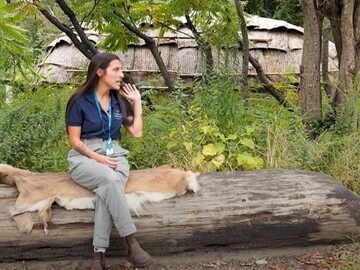Wampanoag Government Across Time
- Date
- 2023
- Material
- Video
- Author/Maker
- Plimoth Patuxet Museums

Description
The Wampanoag are one of many Indigenous nations who inhabited North America long before Europeans arrived along the western Atlantic shores to trade, fish and build communities. They have lived on the bountiful land that is now coastal Massachusetts, eastern Rhode Island, Cape Cod and the Islands for more than 12,000 years.
In the early 17th century, the region was home to as many as 100,000 people organized in some seventy communities ranging in size from a few hundred to a few thousand people. The people in each of these self-governing towns shared a common language and way of life. The sachem had his or her own council and made decisions that best suited the people of the community. Customarily, political leaders were male; leadership often passed from father to son, but it could also be passed down to a daughter. Ousamequin and his two sons, Wamsutta (Alexander) and Metacom (Philip) were leaders, as were Awashonks and Weetamoo, female sachems at Sakonnet and Pocasset respectively, located along the eastern shore of Narragansett Bay.
Even before the time of Ousamequin’s father, who seems to have held the sachemship of Pokanoket
before his son, the Native people of southern New England had some contact with Europeans. They also had a great deal of contact with one another. The many Native nations along the coast of southern New England— including the Wampanoag and the Narragansett in present-day Massachusetts and Rhode Island, the Pequot and Mohegan to the south, and the Nipmuc, Massachusett and Abenaki to the north and west— interacted with one another for thousands of years before Europeans arrived along their shores.
Today, Wampanoag communities are led by an elected Tribal Council which includes a tribal chairperson, vice-chairperson, secretary, treasurer, and seven council members. The chief (a term commonly used today) and medicine man or powawas traditionally sit on the council and hold their positions for life. The Aquinnah and Mashpee Wampanoag are federally recognized as sovereign nations, and the Patuxet or Herring Pond Wampanoag are recognized as a sovereign nation by the Commonwealth of Massachusetts.
Media
What does it mean to be Native/Indian/indigenous/first people in 2017? As the first in a series of conversations with a diverse group of Native political, educational, and cultural leaders from across the country, Interwoven host Hilary Goodnow talks with Dr. Cedric Woods (Lumbee), Trustee of Plimoth Patuxet Museums and the Founding Director of the Institute for New England Native American Studies at University of Massachusetts, Boston.
Who was there in March 1621?
View PDFTranscription
Who was There in March 1621
Plymouth Colony and Pokanoket Population Demographics
Plymouth Colony
Icons demonstrate that in September 1620, 54 adult males, 19 women, and 29 children constituted the community that would found Plymouth Colony.
Icons demonstrate that in March 1621, 23 adult males, 6 women, and 24 children were living in Plymouth Colony.
A pie chart indicates that by March 1621, 48% of the original population of Plymouth Colony were deceased. 52% had survived to March 1621.
Pokanoket
Icons demonstrate that in circa 1600 there were 70,000 Indigenous people living in Pokanoket.
Icons demonstrate that in circa 1621 there were 30,000 Indigenous people living in Pokanoket.
A pie chart demonstrates that between circa 1600 and circa 1620, 70% of the population of Indigenous people living in Pokanoket had died.
According to Tribal Historians, by 1621 the estimated population loss was likely as high as 90% in many Wampanoag communities. Exact population data is no longer known.
Discussion Questions
-
How were Wampanoag communities governed before colonization?
-
How did the arrival of Europeans map makers, fisherman, traders, and colonists impact Wampanoag government structures?
-
What were the different Wampanoag leadership roles? How were the people chosen?